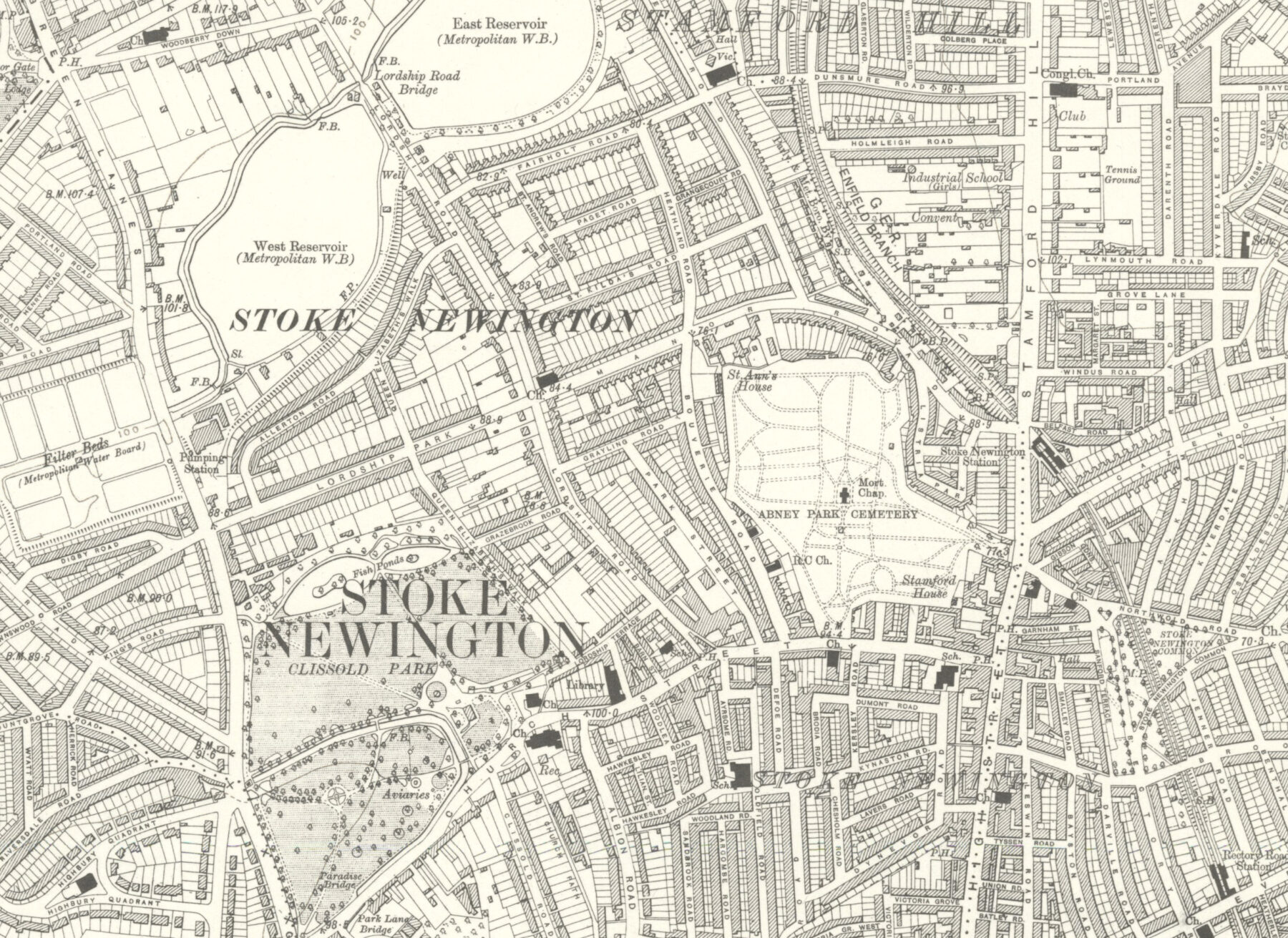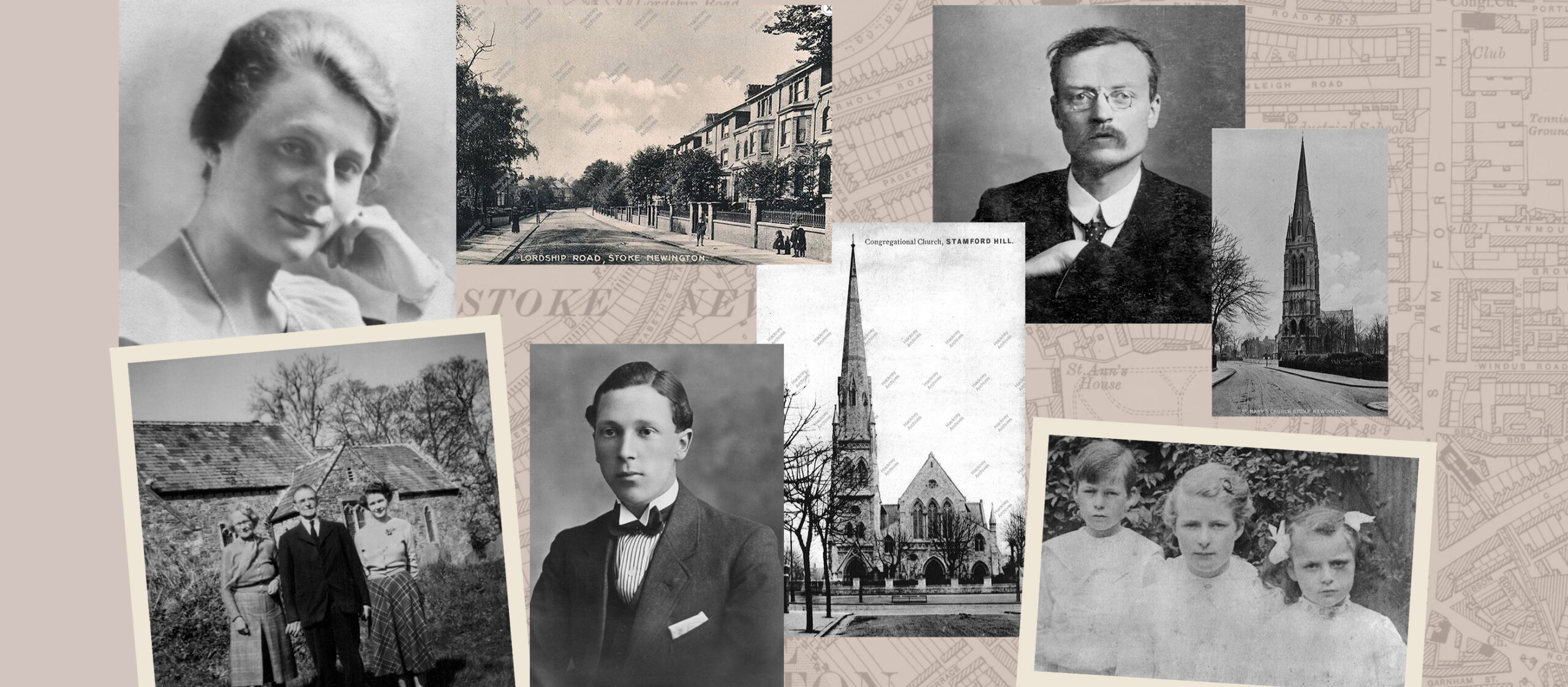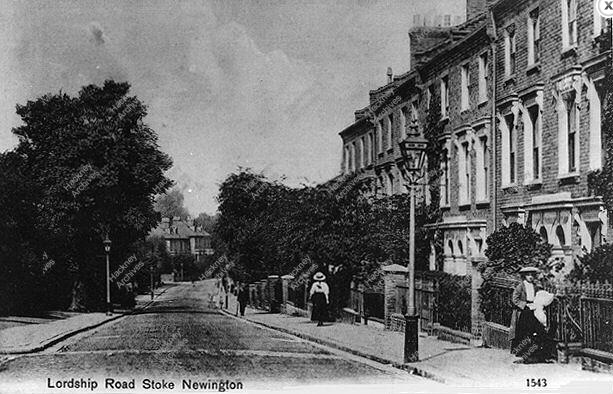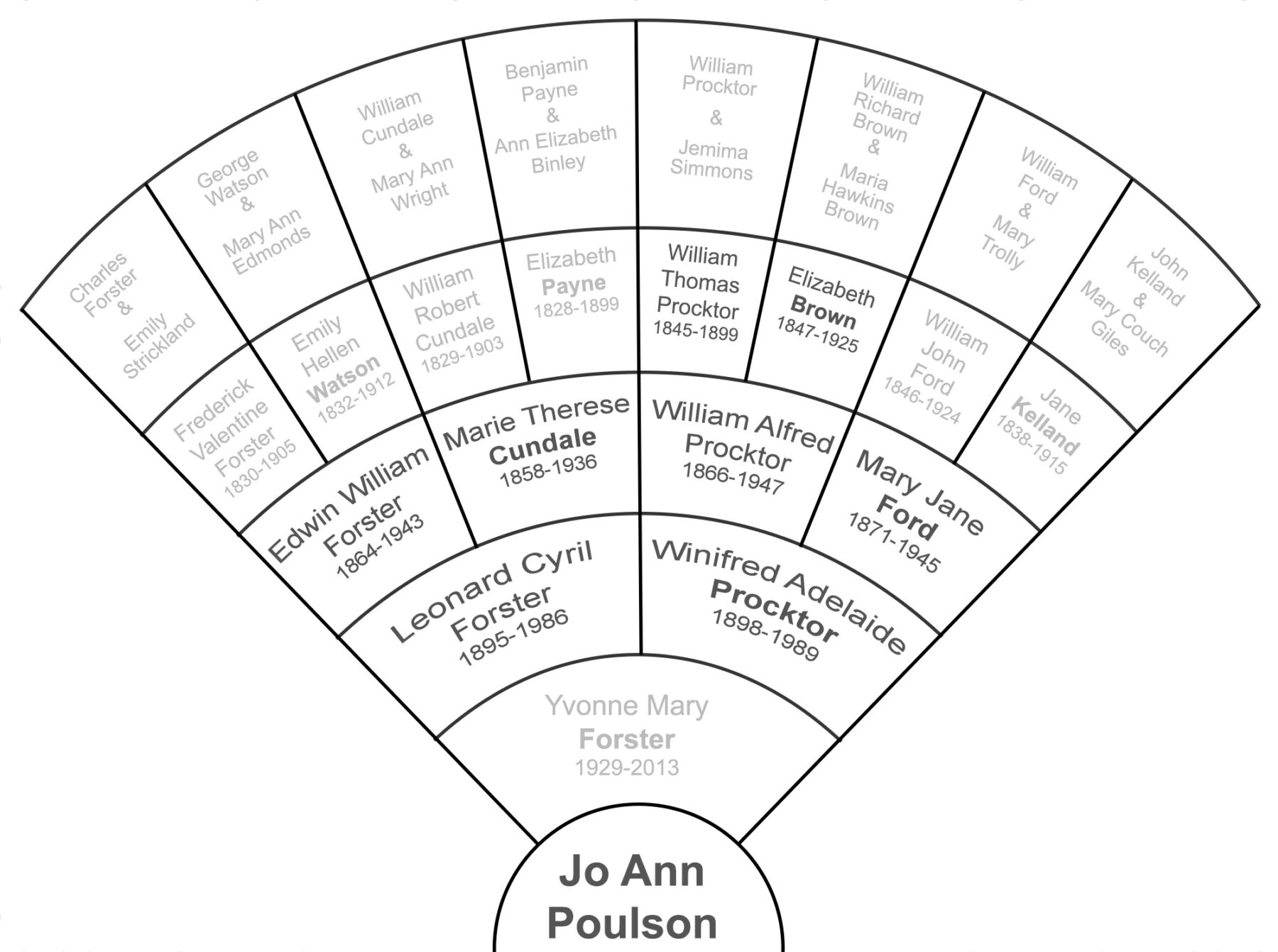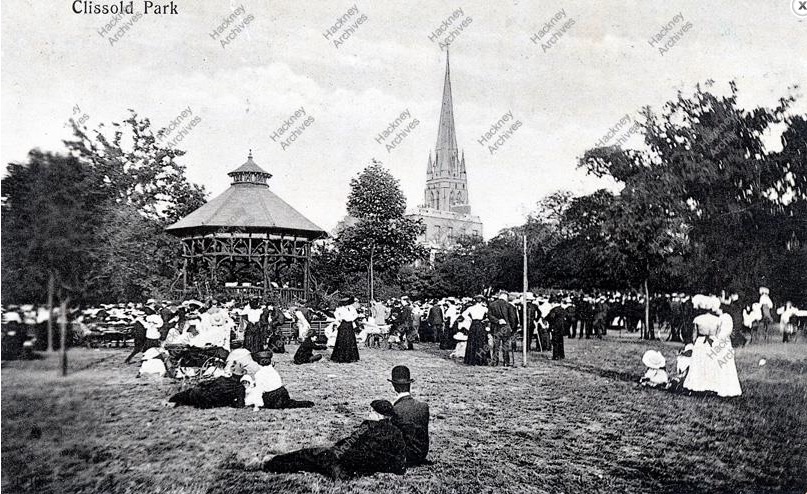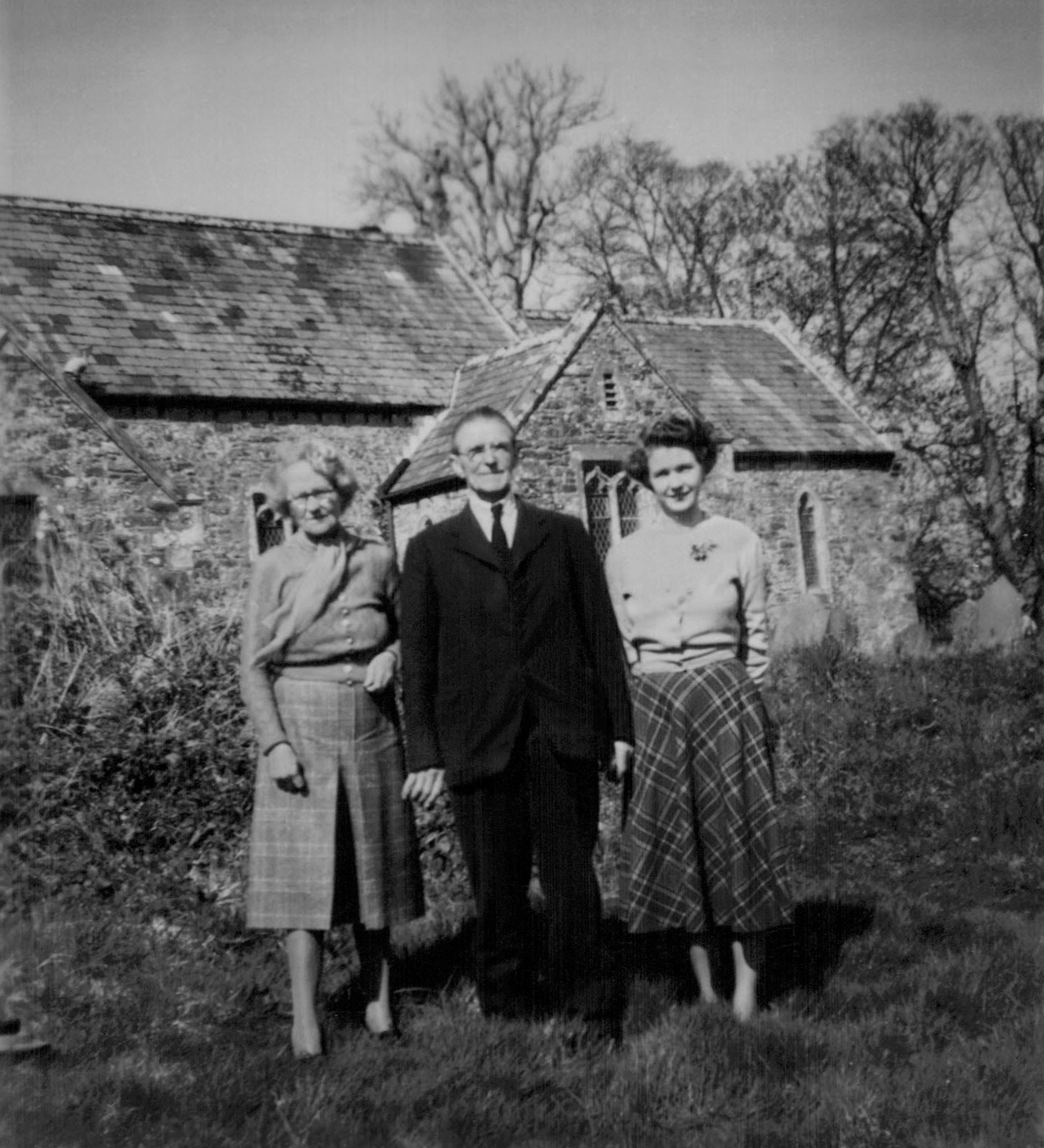I usually think of London as “big” – it certainly felt that way when I was a student there in the 1970s. During recent research on my maternal grandparents and their forebears, I plotted homes (using census and electoral rolls) on an old ordnance survey map. Once I realized how short a walk it was from one house to the other, it became apparent that for three families, Stoke Newington was more like a village than part of the capital city of a huge empire.
To keep family stories from becoming too abstract, I’ve included another bow tie chart showing the relatives mentioned in this story – my mother’s parents, her grandparents, and one set of great grandparents. My mother was born in Chingford, Essex – her parents had moved away from Stoke Newington a year or two earlier – but Wynne’s first cousin, Olive Marie Procktor (whose son was a DNA match, leading to unraveling this tangled family connection) was born in Stoke Newington and baptized in the church in which her parents married.
These families were getting by – just – and they moved from one house to another several times between the late 1800s and 1930 (suggesting they were renting and things weren’t stable). Stoke Newington and its many shops, churches and gorgeous Clissold Park had a lot to offer early 20th century residents. It’s where my grandparents met, and where my great-granduncle, Walter Charles Procktor, met his future wife. Millicent Poyntz Owen, seven of her eight siblings, and her mother moved from a small village in Wales after their schoolmaster father died. The oldest brother, also a school teacher, lyrically named Launcelot Poyntz Owen (not a typo) appears to have formed the new center of their family as they adjusted to life in Stoke Newington. The Procktors and Forsters were all born in the area; the Owens moved from Begelly, a small village on the Pembrokeshire coast in Wales. Launcelot was 26 and the youngest brother was 8. In spite of the many missing pieces – such as how exactly they met one another – I have taped together the pieces of their stories.
William Thomas Procktor returned from Canada in the late 1870s and moved around South Hornsey (first a tenement and then a “dwelling house” before arriving at 90 Park Street Stoke Newington around 1900-01. He was a cabinetmaker with six children – then ages 34 to 17. From the number of times William Thomas moved (electoral rolls have filled in the years between censuses), including several periods where he was a lodger, I assume money troubles/lack of steady work were a continuing problem.
William Thomas’ oldest son, William Alfred (my great grandfather), was a merchant’s clerk, and later a salesman. He was active in a number of non-conformist Christian movements, including Dalston Young Men’s Christian Association, North Hackney Young Men’s Christian Institute and the Brotherhood Movement whose local branch was the Abney Brotherhood. The Abney Brotherhood was where Leonard Cyril Forster met Winifred Adelaide Procktor some time before May 1915 when Len was nearly 20 and Wynne 17. From the two letters I have (from Len to Wynne while she was at school) it appears that William Albert & Janie Procktor, as well as Len & Wynne, were very active participants in the Abney Brotherhood, its music, lectures and philosophy. At one point in a letter, Len reminds Wynne of “the Abney motto” – The best is yet to be – and there are many references to A.B. Committee meetings or lectures. In one, Len remarks about William Alfred (he refers to Wynne’s parents as Father & Mother) chairing an Abney meeting and telling Wynne: “…so you can guess business was pretty brisk. Mr. Peel…is one of the members who has an insatiable lust for arguing. Father went for him ‘hammer & tongs’ on the temperance question and simply wiped the floor with him.” Len also mentioned that Father had said something positive about Len’s work with the orchestra: “It is not very often he says anything and I therefore value his appreciation very highly”. Even though I never met my great grandfather, those characteristics are familiar from Wynne – quick to judge, sharp tongued and more likely to criticize than to praise! Len’s parents were not involved with the Abney Brotherhood – his amateur orchestra work made the connection for him.
Millicent Poyntz Owen met Walter Charles Procktor, William Alfred’s much (14 years) younger brother some time around 1913 when he was 33 and she was 29. Walter was a drapery salesman and Millicent a sick nurse. I don’t think either of them were involved with the Abney Brotherhood and I have no information on how they came to be a couple. For both young couples, World War I was a looming presence, although they had different roles to play. Walter Charles signed up in April 1915 after marrying Millicent in January. He was initially in the reserves, but went to France in 1917 and was discharged with a “disability” in 1919. He had upper & lower dentures which the British Army reckoned was a 20% disability!
Len Forster was rated as unfit for military service because of complications from his peritonitis as a teenager, but he served in France with the Red Cross. He and Wynne were married in 1922 in the Stamford Hill Congregational Church (demolished in the 1960s) within walking distance from their homes. Walter and Millicent were married in the New St. Mary’s Church next to Cissold Park (which is still standing)
Courtesy of the Hackney Archives, here are pictures of the two churches in which Walter & Millicent and Len & Wynne were married

I promised a map of who lived where in Stoke Newington

Although a few locations are no longer there, and some have been modified – most often the car parking spaces where a front garden used to be – it’s possible to see the exteriors of the homes looking largely as they did in the early 20th century. Courtesy of London’s electoral rolls being available on Ancestry, there are a few more details that we can know about the Owens, Procktors & Forsters. When there were property qualifications to be a voter, and a juror, some fascinating details emerge about who was supporting whom in a family – and it wasn’t always the parents supporting their children.

The Owen family, all but one brother, moved away from Begelly after their father died in June 1909. When I filled in details for the family, I found that the oldest boy, Launcelot, had joined the Freemasons in October 1908 and listed an address in Stoke Newington. After I dug around a bit I found the 1909 rolls where Launcelot showed up as a lodger, but the unusual rent entry had my imagination in overdrive. All the other entries I saw were either blank – typically family members lodging (I assume) rent free – or had a specific amount per week/quarter/year. To qualify as a voter, your rates or rent had to be over a threshold as this was before the era of universal suffrage, even for men. My two best guesses were that Launcelot was doing some teaching on the side in return for a rent reduction, or that his difficult circumstances and personal charm led his landlady to offer him a discount! I don’t know why Launcelot moved to London – he was a teacher there – but assume everyone else joined him after their father died the following year. As most of the others were too young or too female to be on the electoral rolls in 1908-9, there’s no way to know.
Another puzzle was that after WWI, William Thomas & Elizabeth Procktor lived with the Owen family at 116 Lordship Road, not with one of their own children (although they had lodged with William Alfred at 3 Paget Rd 1908-1910). Unfortunately for family history research (but not in general; this was a terrible vestige of pre-industrial Britain), the property qualifications were dropped after the war for voting. So you couldn’t tell who was the host and who was being helped once the lodger section was gone. For a while, in order to be eligible as a juror you had to pay rates above a certain value, so finding Launcelot Poyntz Owen marked as the Juror in the “commune” of Owens and Procktors at 116 Lordship Road made it pretty clear that the Owens were helping the aging William Thomas & Elizabeth (76 & 72 at the time).
William Thomas & Elizabeth died in Stoke Newington (1929 and 1925). William Alfred & Janie (1947 and 1945 – she was in a home “incapacitated” from 1939). Walter Charles & Millicent retired to Begelly and after Walter died in 1957, Millicent joined her daughter Olive Marie in British Columbia, where she died in 1978 age 94. Len & Wynne Forster stayed in the London area (but not Stoke Newington) until they retired to Worthing, Sussex, dying in 1986 & 1989.
For those who would like to wander around 1913 Stoke Newington, here is the plain ordnance survey map (thanks to the National Library of Scotland that maintains an online collection of them). Here is the original size of the family map should you want a larger version.
